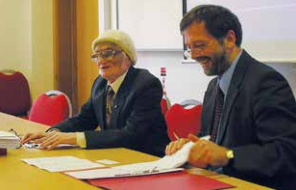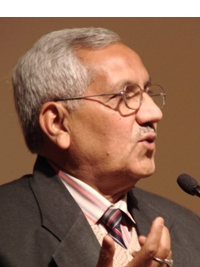
Centre of Jaina Studies Newsletter: SOAS - University of London
Professor M.A. Dhaky, who immortalized Indian temple architecture, passed away after brief illness at his residence in Ahmedabad on 29 July 2016. With his demise we have lost one of the greatest scholars of Indology, loved and respected both by senior and young scholars in India and in other parts of the world.
Dhaky was born on 31 July 1927 into a Svetambara Jaina family in Dhank, village of Porbandar in Gujarat. His father, Sri Amilala Jivanbhai Dhaky, was a horticulture officer. He received his surname Dhaky from his native village Dhank. After completing his primary and secondary education at Porbandar, Dhaky graduated in Geology and Chemistry from Ferguson College, Pune, affiliated to the University of Bombay, in 1948. It is rather surprising that being a science graduate, Dhaky independently cultivated an expertise in the field of Indological studies, especially Archaeology, Art History and Prakrit.[1]
In 1951 Dhaky established an Archaeology Research Group in Porbandar and started writing on Solańki art and architecture. He ultimately joined Junagarh Museum as its Curator and Archaeological Officer. This was the turning point of his life. During this period he met his mentor Professor B. Subbarao and joined him during his excavations at Patan in Gujarat. After stepping into the field of Indian Architecture, Art History and Nirgrantha Studies, Dhaky followed the path shown by three great scholars of Indian sculpture, architecture and painting namely, V. S. Agrawala, C. Sivaramamurti and Moti Chandra.[2] Moti Chandra was aware of the academic potentials of young Dhaky and brought him to the American Academy of Banaras (which subsequently became the American Institute of Indian Studies and shifted from Varanasi to Gurgaon). The writings of Moti Chandra on Indian Art and Culture particularly Kāśī Kā Ītihāsa inspired Dhaky to adopt a holistic approach, and the writings of C. Sivaramamurti inspired him to make full use of original texts in the study of Indian Art. In Varanasi he also came into contact with V. S. Agrawala. Dhaky was greatly influenced by the writings of Agrawala, ranging from Vedic-Puranic to other texts (Matsya-purāņa, Harşa-carita) and early Indian Art. Under this influence and guidance he wrote his book The Vyāla Figures on the Mediaeval Temples of India in 1965.
In 1966 Dhaky joined the American Institute of Indian Studies (AIIS), Gurgaon (Haryana), and became its Research Director in 1976. Although he held no postgraduate degrees, on the basis of his scholarship he was appointed by the L D Institute of Ahmedabad as Professor of Indian Art and Archaeology in 1996.[3] Dhaky's expertise was recognized globally and he acted as supervisor and adviser for doctoral theses on Indian Art and Architecture at Universities in India, London and Berlin.

M.A. Dhaky in the interior of the Navalakha temple, Ghumli, Gujarat. Photographed in 1952. Photograph courtesy Parul Pandya Dhar.
Dhaky retired in 1996 but stayed on in Gurgaon from 1996 to 2005 as Emeritus Director. From 2005 he lived in Ahmedabad.
Prof. Dhaky's works on architecture saw earlymedieval and medieval Indian temple architecture from a unique lens, because he brought fresh methodologies to his analysis. For instance, he categorized Western Indian Temple Architecture into Mahā-Māru, Mahā-Gurjara and Mārugurjara, the latter being an amalgamation of the former two schools. More importantly, he sought to bring to the study of architecture an approach that was not connected to dynastic histories. He saw architecture from an aesthetic viewpoint as well.

M.A. Dhaky & Werner Menski at the SOAS Workshop on Jainism and Society (Photo: P. Flügel 13.3.2006)
Dhaky wrote in English, Gujarati and Hindi with equal command and fluency. In addition to having edited four out of fourteen volumes in the Encyclopaedia of Indian Temple Architecture, his publications include eleven books and over three hundred research articles. The clarity, accuracy and perfection in his writings on Indian monuments, combined with his knowledge of architecture and sculpture, made Dhaky truly an embodiment of the god of architecture (vāstu-puruşa). His books on Chronology of Solańkī Temples of Gujarat (1961), The Ceilings in the Temples of Gujarat (1963), The Embroidery and Beadwork of Kutch and Saurashtra (1966), Bhāratīya Durga-Vidhāna (1971), The Temples of Kumbhāriyā (2001), The Indian Temple Traceries (2005), and Studies in Nirgrantha Art and Architecture (2012) not only continue to inspire scholars of Indian art but also serve as models for the study of Indian temples in terms of the architectural framework and also the symbolic, religious, aesthetic and social contexts.
Of particular note is his publication on Indian Temple Traceries. This was a groundbreaking monograph in its extensive treatment of the subject of Indian temple traceries (jālas or grilles) together with an indepth discussion in light of relevant medieval Vāstuśāstra passages in Sanskrit. Besides identification, classification and description of the different grille types as well as their forms, features and ornaments, it investigates their purpose and relationship with the environment as well as their functional engagement with the building of which each example is an integral part. It likewise traces the origin with its earliest incidences together with the development, of Indian grilles.
Overall, Dhaky always evinced deep admiration for the aesthetic and conceptual quality of ancient and mediaeval South and South-East Asian monuments. Some of his writings bring the South-East Asian regions in dialogue with Indian expressions and a few even primarily on South-East Asian Art.
He also wrote on the history and chronology of ancient and medieval Jaina literature (including the Āgamas, their commentaries and ancient and medieval hymns) as well as determined the dates of the famous authors of Nirgrantha (Jaina) texts. He was an erudite scholar of Prakrit literature, for which the Prākŗt Jñānabhāratī Award was bestowed to him in 1993. Some of his most significant contributions pertain to Jaina ācāryas Bhadrabāhu, Umāsvāti, and Kundakunda.
Professor Dhaky was a multi-talented genius with a deep understanding of aesthetics, Jaina Philosophy and Metaphysics, Prakrit, Jaina Hymnology, Indian classical music (both North Indian and Carnatic), horticulture, gemology and embroidery. He contributed immensely to the understanding of different aspects of Indian art and architecture, including Jainism and Jaina art. He was the recipient of several gold and silver medals, including the Campbell Memorial Gold Medal of the Asiatic Society of Mumbai, the R. C. Parikh Gold Medal of the Gujarat Itihas Parishad, Ahmedabad, and the Hemacandrācārya Award from the Jaswanta Dharmarth Trust Delhi. For his long and invaluable contributions to Indian Art and Culture and Jaina Studies he was awarded prestigious Padma Bhūṣaņa National Award by the President of India in 2010.
Prāsādanidhi, the Felicitation Volume of Prof. M. A. Dhaky (Editors: Parul Pandya Dhar & Gerd J. R. Mevissen) was published in 2016. Its contributions by both foreign and Indian scholars reveal how dear he was to the field of Indian Art History. The point of satisfaction is that the Felicitation Volume could be published in his lifetime.
Dhaky was humble and unassuming but in academic matters he was firm and clear. He was a man of commitment and knew how to nurture and educate a young scholar. He used to spend hours discussing academic issues, and editing research papers of upcoming scholars. [4] He stressed the significance of using the standard technical vocabulary in Sanskrit and also the information we find in inscriptions.
Dhaky combined profound scholarship with extraordinary human qualities, including a fine sense of humour. His wife Śrīmatī Gītāben was in a true sense his best friend. A Jaina by faith, he was free from all narrow sectarian prejudices. The demise of Professor M.A. Dhaky is a great loss felt by many people the world over. He will always live with us in his yaśaḥ-śarīra, or body of glory. I offer my respectful obeisance to the memory of this Great Soul.
Maruti Nandan Tiwari is Emeritus Professor at the Department of History of Art, Banaras Hindu University, Varanasi-221005 (India).
 Prof. Dr. Maruti Nandan P. Tiwari
Prof. Dr. Maruti Nandan P. Tiwari